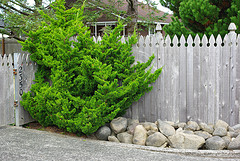Wood Fencing
A wooden fence is a great way to enclose your property while still maintaining your home’s aesthetic appeal. Whether you have small children you want to keep from wandering off, or you want to add privacy, a wooden fence is a great solution.
Advantages of Wood
Wooden fences come in many different materials and styles, and are relatively inexpensive compared to other fencing materials. You can also have it painted or treated in any color so it will match your home. Its versatility enables it to be made into almost any shape, and it’s friendly to the environment, as long as you purchase lumber with Forest Stewardship Council certification. Be sure to have an experienced fence contractor install your fence.
Types of Wood
There are many types of wood to choose from. Depending on your climate, your home’s needs and the look of your yard, certain kinds of fencing might fit best. Consult with a fence contractor to determine the best wood for your fence.
Pine – Pine is the most popular fence material. It’s a soft wood, making it easy to work with, and it can easily be treated to be termite and rot resistant. It also resists shrinkage, swelling and warping.
Spruce – Spruce is a harder wood, which makes it a strong choice. It’s lightweight and has only moderate shrinkage, but it decays in bad weather conditions.
Redwood – Redwood is naturally termite and rot resistant. It’s long lasting, and absorbs finishes extremely well. However, it tends to be more expensive than most other types of fence lumber.
Cypress – Cypress is a hard, durable, aromatic wood, with few knots. It has a natural preservative oil called cypressene which makes it resistant to insects and decay.
Cedar – Cedar has a sweet odor and a nice, reddish color. It’s easy to work with, resistant to decay and long lasting, though it’s relatively expensive.
Types of Fencing
There are many types of fence constructions, each with their own benefits and shortcomings.
Board on Board – This type of fencing has an overlapping panel which creates full privacy. Because of the overlap, the fence is sturdier, but the extra wood makes it cost more.
Stockade – This fence has tightly-placed panels, with no space between them. The style provides privacy, though over time, as the boards warp, gaps appear and the privacy diminishes.
Post and Rail – This choice of fence creates a country look, as it is common on farms. It consists of vertical posts with horizontal boards running from post to post.
Picket Fence – Around since the colonial era, the picket fence, consisting of vertical pickets supported by horizontal strips, is still a popular choice today. It adds beauty to a home and creates a clear property boundary, but provides no privacy.
Special Finishes
Once you’ve decided what style of fence to install, you may want to add a special finish. This will transform your fence from a simple barrier to a charming part of your landscape.
Dipped or Oval – You can have the top line of the fence curve either downward or upward, leaving the middle of the fence a different height than the outer ends. This style adds a more welcoming feel to any type of fence.
Dog Eared – The top of each panel has a rounded edge instead of a squared or pointed edge, giving it a softer, friendlier look.
Lattice Work – Usually about one foot tall, the lattice work goes at the top of your fence, creating a more stylistic, appealing look.
Be sure to apply a weather seal and have your fence treated. If you seal your fence periodically and paint or stain it regularly, you’ll get many more years out of your fence.
Related Articles
Looking for a Pro? Call us (866) 441-6648

Fencing Average Costs
Fence Contractors Experiences

My New Fence Features Excellent Workmanship

The Best Contractor: Prompt, Accurate And Ready For The Unexpected




